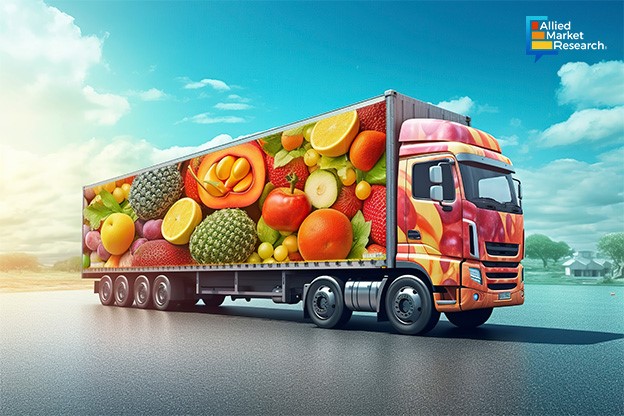How Have Innovations in Food Logistics Improved the Revenue Share of the Food & Beverages Domain?

15 May
2024
Highlights:
- Introduction
- Technological advancements in the industry
- The growth of the sector in the Asia-Pacific region
The logistics sector is an essential component of supply chain management as it covers every operation from the origin or production of a commodity to its final delivery to its consumer. Thus, the logistics sector covers all the important processes including transportation, processing, storage, and distribution. Naturally, it plays an extremely vital role in the smooth functioning of the global economy. For businesses in the food and beverages industry, strong and adaptable logistics solutions are highly important for maintaining profitability.
Understanding the latest trends adopted by food logistic companies to increase their profitability
A typical food processing or packaging company supply chain includes production, processing, packaging, storage, inventory management, warehousing, distribution, retailing, and consumption. The food logistics industry has a critical role to play in each of these operations. The primary job of the food supply management and logistics industry is to maintain the freshness and quality of the food item that is undergoing all these processes and ensure its safe delivery to the end-user.
Food logistics companies take into account all these operations and make sure that the food product remains protected from contamination and spoilage. This becomes even more important in the case of perishables like horticulture products, meat products, and dairy items which can get damaged with the slightest changes in temperature and other climatic conditions.
In the past few years, to achieve these objectives food logistics companies are increasingly investing in advanced technologies like Artificial Intelligence, blockchain, the Internet of Things, and data analytics. These technologies have helped logistics companies plug gaps in their workflow and improve their operational efficiency. For instance, studies have shown that IoT-powered systems can significantly reduce the food wastage that is prevalent in the food processing and transportation industries. Using IoT, food logistics companies can track and monitor the delivery of food products in real-time, and thus respond quickly if any emergency arises.
Similarly, Artificial Intelligence has proven to be beneficial in intelligent route planning; companies, by employing AI tools chalk out delivery routes in such a way that the hurdles faced by the driver are minimal. While planning such a route, the AI-powered system also takes into account the climatic conditions, vehicular traffic, checkpoints, and many more. Apart from this, AI also helps in a quicker and more efficient inspection of the delivery package and removes the delays associated with manual supervision.
Blockchain technology is another important technology that has enhanced the scope of the food logistics industry. Food adulteration is one of the biggest problems faced by food packaging and processing companies. By putting in place a secure blockchain system, unauthorized access to delivery packages can be avoided, thereby ensuring transparency in the entire supply chain. Also, since blockchain technology acts as a decentralized ledger, different stakeholders in the supply chain can update the ledger simultaneously, thereby improving the monitoring process.
Asia-Pacific region to record the highest growth rate in the 2023-2032 period
As the rate of economic growth and development has increased in the developing countries of Asia-Pacific, the lifestyle of people living in this region has become more fast-paced. As a result, people are increasingly looking for packaged and ready-to-eat foods. Also, the e-commerce sector in these countries has experienced a major boost due to the increasing penetration of digital services. All these factors have led to a surge in demand for last-mile food delivery. To adapt to this change, food processing industries are investing in improving their logistics departments to ensure seamless doorstep delivery of food products and groceries.
At the same time, the companies in this region have readily adopted advanced technologies such as AT, data analytics, and IoT, and integrated with their existing logistics infrastructure to enhance the revenue share of this industry. The use of automated solutions to safeguard last-mile delivery of goods and services is another characteristic feature witnessed in various countries of this region. Due to these reasons, the Asia-Pacific industry is set to grow at a CAGR of 9.1% in the 2022-2032 period.
To summarize, the vital role played by the food logistics sector in increasing the profitability of food processing and packaging industries has increased the foothold of this sector globally. Along with this, the growing adoption of emerging technologies such as IoT and AI is expected to augment the growth rate of the sector, especially in the Asia-Pacific region.
For tips and suggestions on how businesses must capitalize on the opportunities offered by the industry, feel free to contact us.

Akhilesh Prabhugaonkar
Author's Bio- Akhilesh Prabhugaonkar holds a bachelor’s degree in Electronics Engineering from the reputed Vishwakarma Institute of Technology. He has a special interest in the fields of forensics, world history, international relations and foreign policy, sports, agriculture, astronomy, security, and oceanography. An ardent bibliophile and melophile, Akhilesh loves to write on topics of his interest and various other societal issues. This love for writing made him enter the professional world of content writing and pursue his career in this direction.
Avenue: Entire Library membership of Allied Market Research Reports at your disposal
- Avenue is an innovative subscription-based online report database.
- Avail an online access to the entire library of syndicated reports on more than 2,000 niche industries and company profiles on more than 12,000 firms across 11 domains.
- A cost-effective model tailored for entrepreneurs, investors, and students & researchers at universities.
- Request customizations, suggest new reports, and avail analyst support as per your requirements.
- Get an access to the library of reports at any time from any device and anywhere.
Related Post
-
How are Submarine Cables Transforming Global Connectivity with Enhanced User Experience?
-
Endoscopy Procedures: Transformations in Techniques and Applications
-
AI-Powered Video Analytics: How the Product Actually Works for enterprises
-
Painting Robots: Transforming Precision Coating and Creative Applications
-
Innovations in Pharmacovigilance Systems Advancing Patient Safety
-
Understanding Edge Security: Keeping Data Safe Near the Source
-
Exploring the Use and Advancements of 3D Laser Scanners in Professional Applications
-
Reinforcing Industrial Controls with Smarter Tools and Training








